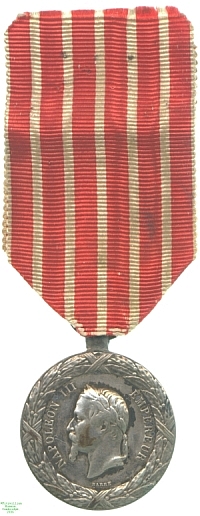Médaille d'Italie, issued in 1859

Obverse, a bust of Emperor Napoleon III wreathed and facing left, surrounded by a laurel wreath
|

Reverse, a bound wreath surrounding the inscription and a central inscription that reads "MONTEBELLO / PALESTRO / TURBIGO / MAGENTA / MARIGNAN / SOLERINO"
|
<- Previous | Next ->
Back to gallery page
Médaille d'Italie, 1859 (Franco-Austrian War)
Long before the so-called `year of Revolutions', 1848, there had been political factions urging the unification of the disparate Italian states, but the Austrian Empire, which ruled Lombardy and Venetia, had successfully repressed several risings. The rulers of Sardinia cherished the ambition of leading the unification process, and therefore in 1858 the Sardinian Prime Minister, Camillo Benso di Cavour, and Emperor Napoléon III of France concluded an alliance against Austrian rule in the Italian Peninsula. Border provocations led Austria to demand Sardinian disarmament in 1859, and after this was refused war was joined in late April.
The Austrian leadership did not join battle quickly enough to prevent the French reinforcing the Sardinians as per their alliance, and thereafter the Franco-Sardinian forces had the upper hand in combat despite being outnumbered. Increasing German disapproval however led Napoléon to seek an armistice, without Sardinia's approval. The resulting treaty, signed on 11 July 1859, ceded Lombardy to France for further transfer to Sardinia but restored the pro-Austrian rulers in Central Italy. In fact the treaty was never fulfilled, as the Sardinians who had taken over in Tuscany, Modena and Parma would not relinquish their positions, forming a short-lived Republic of Central Italy, which was annexed by Sardinia proper in 1860. In return for its support France received Savoy and Nice.
An unforeseen result of this was the great impulse it gave to the Italian nationalist Guiseppe Garibaldi, whose Hunters of the Alps had been instrumental in beginning the conflict with Austria but whose origins in Nice left him outraged at the final outcome. The war led directly to Garibaldi's expedition to Sicily and the fall of the Kingdom of the Two Sicilies.
As early as 1859 Emperor Napoléon III ordered the issue of a campaign medal for service in the Franco-Austrian War. The reverse bears the names of the major French successes against the Austrians. This example is unnamed, and it cannot now be known to whom it was awarded. Although this medal is part of the Watson Collection, Lester Watson's own lists give no provenance for it.

